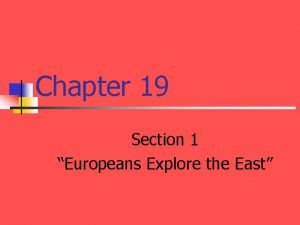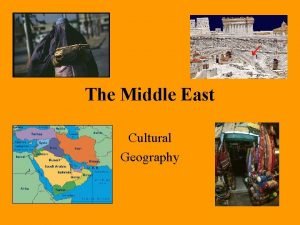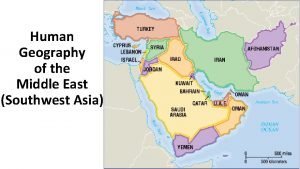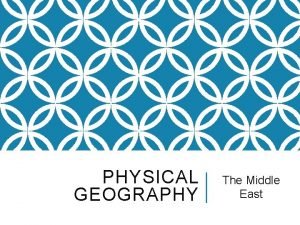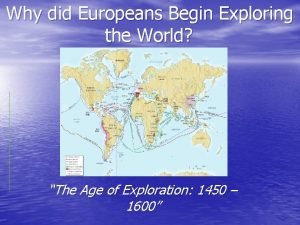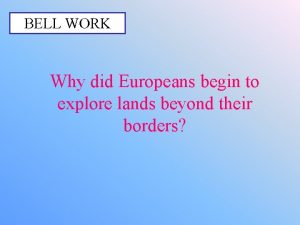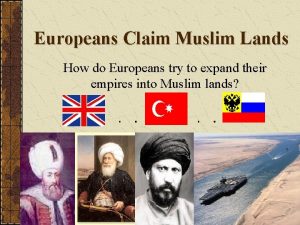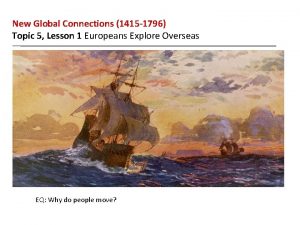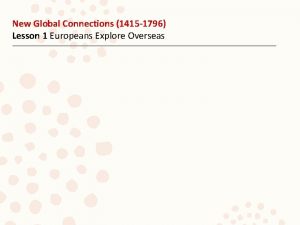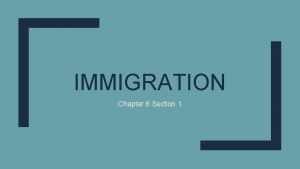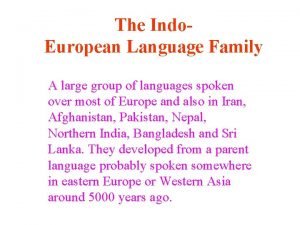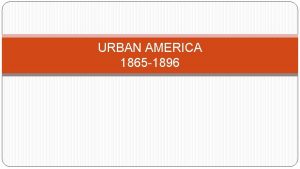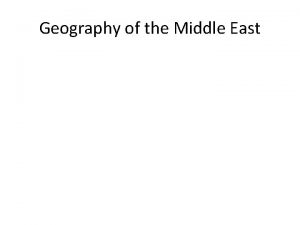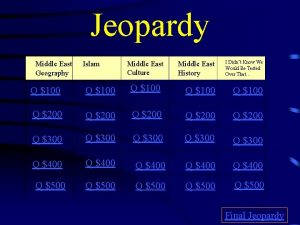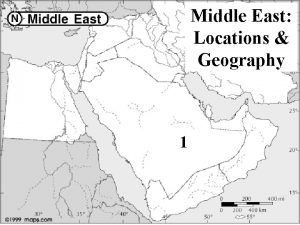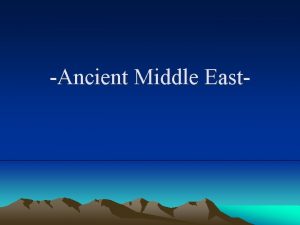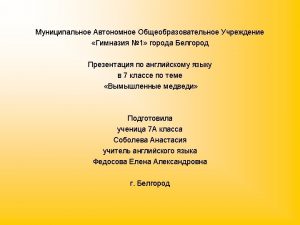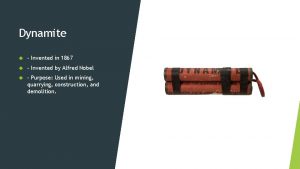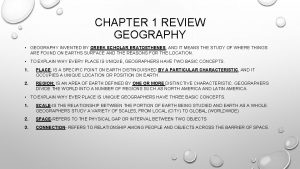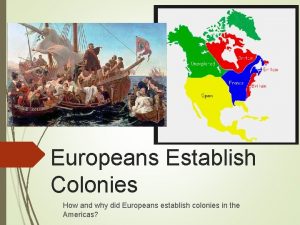Middle East Geography Europeans invented the term Middle



















- Slides: 19

Middle East Geography

Europeans invented the term “Middle East” to describe the region that lies between Europe and the distant parts of Asia- what was once called the Far East. The Middle East is the crossroads of three continents: Africa, Asia, and Europe. Although the US government does refer to this region as the Middle East, many others refer to the region rightfully as Southwest Asia and North Africa.

Despite a common arid climate and a general religious preference for Islam, there is much geographic and cultural variety throughout this region. Oil is present in abundance in some countries, but totally absent in others. In some parts of the region, nearly everyone lives in a city; in other parts, rural life is dominant. In some countries, civil laws are heavily influenced by religious law; others have secular legal systems. Before evaluating the rich cultures and traditions which have developed in this regions, it is imperative to understand the geography of the Middle East.

Location Place Region Human. Environment Interaction Movement

LOCATION • The Middle East stands at the crossroads of three continents: Africa, Asia, and Europe. Since ancient times, it has connected major trade routes, both overland on the seas. • Remember that absolute location is the exact point on the Earth where a place can be found (latitude and longitude) and that relative location is a description of a place in comparison to other places.

PLACE- HUMAN CHARACTERISTICS • The Middle East is home to many different people with a variety of languages, religions and traditions. Among the major languages of the region are Arabic, Turkish, Hebrew, Kurdish, Persian, Greek, and Armenian. Religions include Islam, Christianity, and Judaism. The regionincluding the Maghreb-consist of 21 countries and almost 350 million people.

• Arabs are the majority group in many Middle Eastern countries. But what is an Arab? Beginning in the mid-600 s, Arabs from the Arabian Peninsula conquered many different peoples in the Middle East and North Africa. Over time, the conquered people adopted the Arabic language and many adopted the religion of Islam. They, too, became known as Arabs. Today, the term Arab is used to describe anyone whose native language is Arabic. Within this large group, however, Arabs differ greatly from one another. Besides, Arabs, the Middle East is home to other ethnic groups such as Turks, Iranians, and Kurds. Some of these groups migrated to the Middle East from other parts of Asia. They all have their own languages and traditions.

REGION • As elsewhere around the world, physical features have affected human settlement in the Middle East. The five main physical regions of the Middle East are the Northern Tier, Arabian Peninsula, Fertile Crescent, Nile Valley, and the Maghreb.

• Northern Tier- The Northern Tier stretches across present day Turkey and Iran. It is a region of mountains and plateaus. In the west lies the Anatolian Plateau, ringed by the Pontic and Taurus mountains. The Anatolian Plateau has fertile soil and receives enough moisture to support farming. As a result, it has a large population. – The Anatolian Plateau is located in Asia Minor, a large peninsula which connects Asia and Europe. – To the east lies the Iranian Plateau. Like Anatolia, it is ringed by mountains including the Elburz and Zagros ranges. Unlike Anatolia, however, most of the region is dry and the population remains small.

• Arabian Peninsula- The Arabian Peninsula is a vast plateau that is about 1/3 of the size of the United States. It borders on several important bodies of water, including the Red Sea, the Arabian Sea, and the Persian Gulf. Saudi Arabia is the largest nation in the region. The Arabian Peninsula has a small population. The reason is lack of water. Except for some fertile areas on the mountainous southern coast, the peninsula is a barren desert. Most people in the region live around scattered oases. An oasis is a fertile desert area that has enough water to support plant and animal life. The Arabian Peninsula has large amounts of oil deposits. It is also the birthplace of Islam.

• Fertile Crescent- The Fertile Crescent is the arc shaped region that stretches from the eastern Mediterranean along the Tigris and Euphrates rivers to the Persian Gulf. Rich soil and abundant water have made it a major population center. One of the world’s earliest civilizations emerged in the fertile Tigris-Euphrates Valley. – Wealthiest settlements in the Fertile Crescent lie in Mesopotamia, “the land between the rivers. ”

• Nile Valley- The Nile Valley enjoyed geographic advantages that Mesopotamia did not posses. Forbidding deserts in the east and west protected it from invaders, and the flooding of the Nile River was both predictable and dependable. – In ancient times, trade and other contacts linked Egyptians in the Nile Valley with the peoples of the Fertile Crescent. From Egypt caravans and armies crossed the Sinai Peninsula, while ships sailed from Nile delta ports to lands adjoining the Mediterranean. • The Maghreb- The Maghreb includes the North African nations of Algeria, Tunisia, and Morocco. Fiver other African Nations- Libya, Chad, Niger, Mali, and Mauritania - share geographic and cultural links with the Maghreb. Among the chief features of the Maghreb are the vast Sahara and the rugged Atlas Mountains. Because of the scarcity of water, both areas have few inhabitants. Most people live along the Mediterranean coast, which has fertile soil and plenty of rain. This area commands the southern rime of the Mediterranean as well as the gateway to the Atlantic.

HUMAN ENVIRONMENT INTERACTION • Climate has dictated where people live in the Middle East. Nearly all the region is desert. People have clustered in wellwatered areas along the coasts and in river valleys where they irrigate and farm the land. Settlements were scattered. Many separate nations developed throughout the Middle East.

• Lack of rainfall and scarcity of water have shaped the cultures of the Middle East. Less than 10 percent of the land receives enough water to make farming possible. From earliest times, people built irrigation systems to carry water from rivers to crops. Ancient Egyptians used the shaduf, a simple water hoist, to transfer water from ditches and canals to their fields. Modern technology has improved upon older irrigation methods, and people have developed new ones such as drip irrigation, which delivers a measured amount of water to each plant. The nations of the Arabian Peninsula also have invested huge amounts of money in desalination plants, which convert the water from the surrounding seas into fresh water.

• Oil- The Middle East has a variety of resources, including salt, phosphatewhich is used in fertilizers- and copper. The most valuable resource, however, is oil. It is unevenly distributed across the region. As a result, great economic differences exist between oil rich countries and those that lack oil. Click on the link below to view a map and list of oil production and consumption world wide as of 2012. http: //world. bymap. org/Oil. Reserves. html

MOVEMENT • The Middle East stands at the crossroads of three continents: Africa, Asia, and Europe. Since ancient times, it has connected major trade routes, both overland on the seas. Caravans from India and China brought goods to busy markets of the Middle East. From there, traders carried the goods across the Mediterranean into Europe. Today, Middle Eastern nations still command vital sea routes.

• Suez Canal- The Suez Canal is an artificial waterway running north to south across the Isthmus of Suez in northeastern Egypt; it connects the Mediterranean Sea with the Gulf of Suez, an arm of the Red Sea. The canal provides a shortcut for ships operating between both European and American ports and ports located in southern Asia, eastern Africa, and Oceania. The construction of the Suez Canal represents not just the geographic theme of movement, but also the geographic theme of human environment interaction.

Click on the following link to learn more about the construction and operation of the Suez Canal. http: //www. touregypt. net/featurestories/sue zcanal. htm

 Slave
Slave Laissez faire theory
Laissez faire theory Cultural geography of the middle east
Cultural geography of the middle east Human geography of the middle east
Human geography of the middle east Physical geography of middle east
Physical geography of middle east Everything that has been invented
Everything that has been invented Has everything been invented
Has everything been invented Horizontal movement of air is called
Horizontal movement of air is called East is east and west is west
East is east and west is west Why did europeans start exploring
Why did europeans start exploring Lesson 1 europeans explore overseas
Lesson 1 europeans explore overseas Why did europeans begin to explore
Why did europeans begin to explore Europeans claim muslim lands
Europeans claim muslim lands Topic 5 review questions new global connections answer key
Topic 5 review questions new global connections answer key Lesson 1 europeans explore overseas
Lesson 1 europeans explore overseas Europeans flood into america
Europeans flood into america Europeans set sail
Europeans set sail Tava nama kim
Tava nama kim Sources us eu us europeans
Sources us eu us europeans Europeans
Europeans
